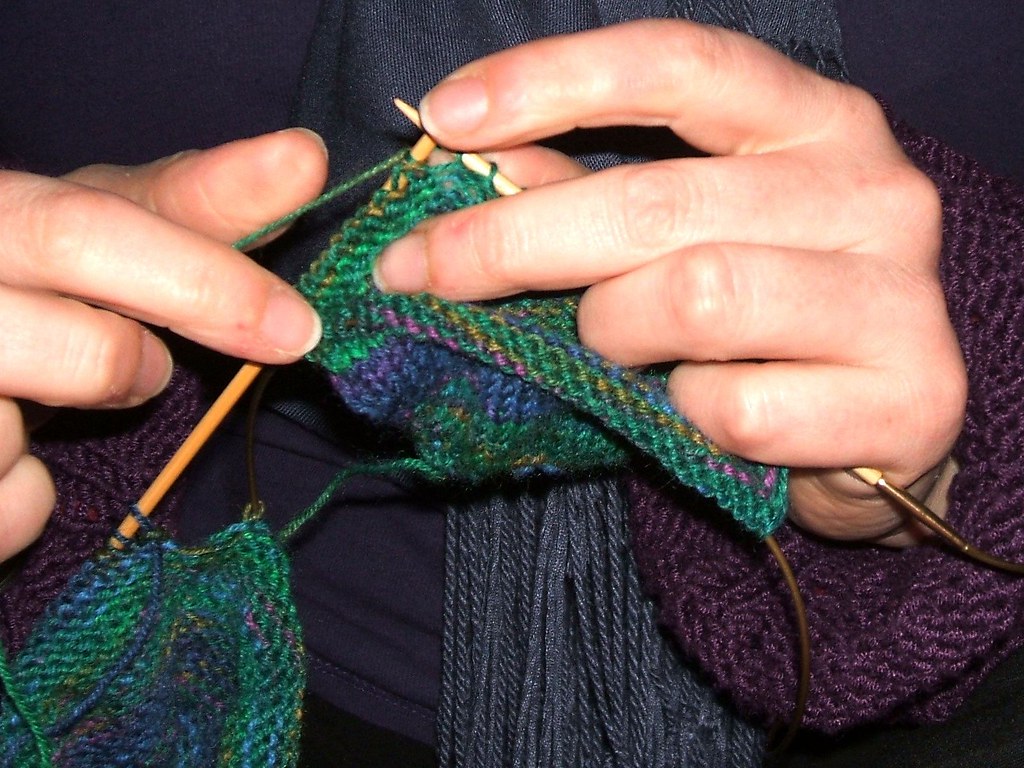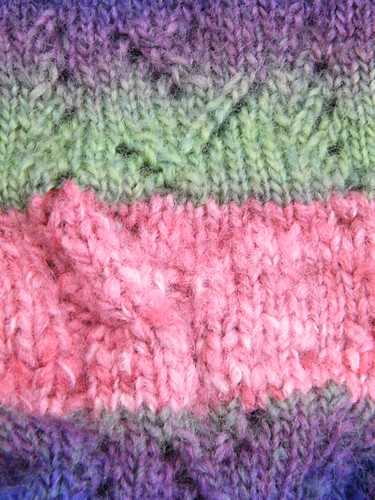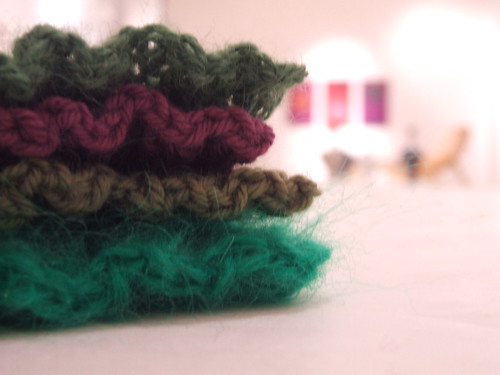About five years ago, as the result of an inspired if chancy Christmas gift from my partner, I learned how to knit. After three days of cussing at yarn and needles, I finally taught myself the basics. From there, my learning curve was steep. More than just an avocational distraction, I found knitting (and later crochet) stimulates my thinking about a variety of academic projects as well as my participation in on-line communities. Maybe it's the time involved in meditative looping and counting and maintaining a consistent tension that frees the mind to wander and make associations; maybe there's something deeply metaphysical about careful and planned manipulation of strand into fabric into garment.
So, I was very excited when a member of @Platea proposed a project involving knitting from a crowdsourced pattern generated on Twitter. Ingrid Murnane's
project not only intrigues me as a knitter, but also as an artist and academic who spends considerable time thinking about art and communities. Several themes emerge for me as I contemplate the Plateaknit project and the link between knitting and on-line networks. This is by no means an exhaustive list. In fact, as with all performance inquiry, I look forward to our adding to and modifying this list as we engage in the project.
1)
Networks/Knitworks -- As a textile craft, knitting (like crochet and weaving) is about creating a material network of fibers in a lattice. The kind of free-form knitting this project prefers (in crochet, sometimes called "
scrumbling") is even more like the organic, chaotic networks of folks linked by the internet, (in Network Theory, sometimes called
mesh networks). And if the net is still predominantly text-based, it is worth remembering that "text" and "textile" are etymologically
linked. (Hey, we don't call it a "web" for nothing!) It is also worth remembering that the computers we use to have this discussion owe their data processing origins, in part, to the textile industry of
weaving.
2)
DiY Aesthetics -- Performance Studies folks have been talking a lot about this idea lately -- the idea of media and art production done outside traditional institutions and training for such, and often not for any kind of financial gain. The concept borrows a bit from the logic of the potlach and economies of gift-giving. In explaining the DiY aesthetic, my partner (a fellow Performance Studies scholar) and I often reference our knitting and crochet practices: we make scarves and hats for the pleasure of making them and then enjoy giving them away. The joy is a product made by the hand of someone you know and not simply bought or manufactured in institutionalized systems of exchange. In an increasingly globalized culture of consumerism, knitting (among other arts/crafts) at the very least expresses a desire for something other than the mass produced. (Although, admittedly, there is plenty about knitting that supports commodity fetishism -- as a proliferation of specialty stores, expensive yarns, and my colossal fiber cache demonstrate.)

3)
Social Knitworking -- If
Ravelry.com is any indication (and it is not alone in this), the relatively recent revitalization of knitting has benefited significantly from social networking. Blogs and social networking sites abound for sharing knitting resources and projects. Several folks have even taken advantage of webcams to produce (really helpful!)
tutorial videos. This is the sort of hobby/art/craft that seems to thrive in and form non-geographically-bound, interest-based communities.
4)
Specialized Codes -- I think the
specialized abbreviations of knitting instructions (easily one of the most frustrating aspects of learning to knit) are a lot like the
specialized abbreviations used in text messages and character-constrained micro-blogging. Both endure a certain amount of push-back from folks who find such abbreviation alienating and unnecessary. And yet, in both cases, there are similar motivations for the abbreviations. For texting and micro-blogging, character limits and numeric keypads necessitated the organic development of abbreviations. For knitting, abbreviations first showed up in newspapers that limited the column inches available for craft instructions. In both cases, these abbreviations have found their way into discourse less constrained by need for such efficiency.
5)
But is it Art? -- Finally, at a time when digital art and social networking performance events still (occasionally) suffer derisive dismissal by established "fine" arts practitioners, knitting offers a practice similarly caught in categorical debates between "craft" and "art." Certainly, there are
textile artists who use knitting to make soft sculptures, and for some this leads to a tension between knitting for practical use and knitting for an art object. Nonetheless, it is rare that knitting finds its way into a regular part of the the Fine Arts curriculum. A potentially interesting alchemy occurs when we mix the two forms -- one relatively new, one relatively old, and both viewed with some skepticism by the Keepers of the Canon.
With these thoughts looping back on each other in my mind, I find myself eager for the needles and tweets that will weave this next @Platea project.
(Posted by Jonny Gray, a.k.a. Bungy32. All illustrations in this post created by me.)

















